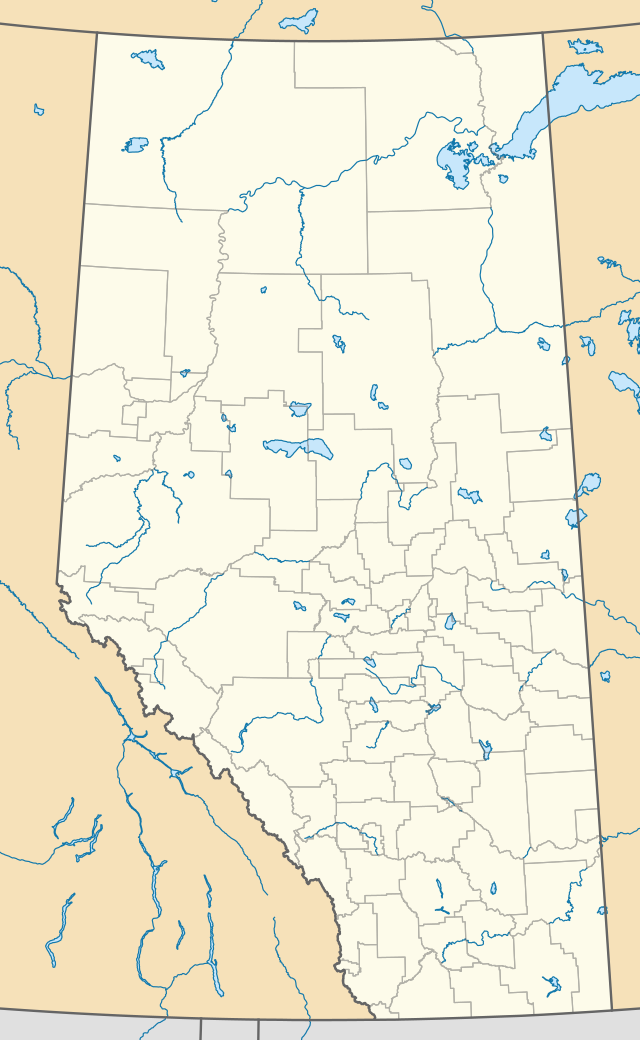Vauxhall, Alberta
Vauxhall is a town in southern Alberta, Canada within the Municipal District of Taber. It is located on Highway 36 (Veteran Memorial Highway) approximately 36 km (22 mi) north of Taber, 69 km (43 mi) south of Brooks and 114 km (71 mi) west of Medicine Hat. It is situated in the prairie land between Bow River and Oldman River.
Vauxhall | |
|---|---|
Town | |
| Town of Vauxhall | |
 Main Street in Vauxhall | |
| Motto(s): Potato Capital of the West | |
 Vauxhall Location of Vauxhall in Alberta | |
| Coordinates: 50°04′08″N 112°05′51″W | |
| Country | |
| Province | |
| Region | Southern Alberta |
| Census division | 2 |
| Municipal district | Municipal District of Taber |
| Incorporated[1] | |
| • Village | December 31, 1949 |
| • Town | January 1, 1961 |
| Government | |
| • Mayor | Margaret Plumtree |
| • Governing body | Vauxhall Town Council |
| Area (2016)[3] | |
| • Land | 2.72 km2 (1.05 sq mi) |
| Elevation | 779 m (2,556 ft) |
| Population (2016)[3] | |
| • Total | 1,222 |
| • Density | 449.4/km2 (1,164/sq mi) |
| Time zone | UTC-7 (MST) |
| Highways | Highway 36 Highway 864 |
| Website | Official website |
Vauxhall is known as the "Potato Capital of the West."

Demographics
In the 2016 Census of Population conducted by Statistics Canada, the Town of Vauxhall recorded a population of 1,222 living in 413 of its 458 total private dwellings, a -5.1% change from its 2011 population of 1,288. With a land area of 2.72 km2 (1.05 sq mi), it had a population density of 449.3/km2 (1,163.6/sq mi) in 2016.[3]
In the 2011 Census, the Town of Vauxhall had a population of 1,288 living in 429 of its 458 total dwellings, a 20.5% change from its 2006 population of 1,069. With a land area of 2.88 km2 (1.11 sq mi), it had a population density of 447.2/km2 (1,158.3/sq mi) in 2011.[5]
Infrastructure
The town is served by the Vauxhall Airport, located 5 kilometres (3.1 mi) south of the town.
Education
The Town of Vauxhall is served by two schools, Vauxhall High School and Vauxhall Elementary School.
Geography
Climate
Like much of southern Alberta, Vauxhall experiences a semi-arid climate (Köppen climate classification BSk). In winter the community is prone to a Chinook wind which blows off the Rocky Mountains. This can bring periods of extremely warm temperatures relative to what would normally be seen at that time of year. The highest temperature ever recorded in Vauxhall was 40.6 °C (105 °F) on 16 July 1919 and 20 July 1921.[6][7] The coldest temperature ever recorded was −48.9 °C (−56 °F) on 12 January 1916.[8]
| Climate data for Vauxhall, 1981–2010 normals, extremes 1913–present | |||||||||||||
|---|---|---|---|---|---|---|---|---|---|---|---|---|---|
| Month | Jan | Feb | Mar | Apr | May | Jun | Jul | Aug | Sep | Oct | Nov | Dec | Year |
| Record high °C (°F) | 19.4 (66.9) |
24.0 (75.2) |
27.5 (81.5) |
33.3 (91.9) |
35.0 (95.0) |
37.8 (100.0) |
40.6 (105.1) |
39.9 (103.8) |
37.8 (100.0) |
31.0 (87.8) |
22.2 (72.0) |
17.5 (63.5) |
40.6 (105.1) |
| Average high °C (°F) | −2.9 (26.8) |
0.5 (32.9) |
6.1 (43.0) |
13.7 (56.7) |
19.0 (66.2) |
22.3 (72.1) |
25.5 (77.9) |
25.8 (78.4) |
20.7 (69.3) |
13.4 (56.1) |
4.5 (40.1) |
−0.6 (30.9) |
12.3 (54.1) |
| Daily mean °C (°F) | −9.2 (15.4) |
−6.1 (21.0) |
−0.9 (30.4) |
6.0 (42.8) |
11.4 (52.5) |
15.4 (59.7) |
17.7 (63.9) |
17.4 (63.3) |
12.4 (54.3) |
5.7 (42.3) |
−1.9 (28.6) |
−6.8 (19.8) |
5.1 (41.2) |
| Average low °C (°F) | −15.4 (4.3) |
−12.7 (9.1) |
−7.8 (18.0) |
−1.6 (29.1) |
3.8 (38.8) |
8.6 (47.5) |
10.0 (50.0) |
8.9 (48.0) |
4.1 (39.4) |
−1.9 (28.6) |
−8.2 (17.2) |
−12.9 (8.8) |
−2.1 (28.2) |
| Record low °C (°F) | −48.9 (−56.0) |
−43.3 (−45.9) |
−38.5 (−37.3) |
−25.6 (−14.1) |
−11.7 (10.9) |
−2.2 (28.0) |
−0.6 (30.9) |
−1.0 (30.2) |
−10.6 (12.9) |
−29.4 (−20.9) |
−36.0 (−32.8) |
−45.0 (−49.0) |
−48.9 (−56.0) |
| Average precipitation mm (inches) | 11.1 (0.44) |
10.0 (0.39) |
15.3 (0.60) |
25.1 (0.99) |
40.0 (1.57) |
72.9 (2.87) |
32.9 (1.30) |
32.9 (1.30) |
34.9 (1.37) |
14.4 (0.57) |
15.0 (0.59) |
11.6 (0.46) |
316.0 (12.44) |
| Average rainfall mm (inches) | 0.0 (0.0) |
0.2 (0.01) |
2.3 (0.09) |
17.7 (0.70) |
35.7 (1.41) |
72.9 (2.87) |
32.9 (1.30) |
32.5 (1.28) |
33.9 (1.33) |
9.0 (0.35) |
1.8 (0.07) |
0.6 (0.02) |
239.5 (9.43) |
| Average snowfall cm (inches) | 11.1 (4.4) |
9.8 (3.9) |
12.9 (5.1) |
7.4 (2.9) |
4.2 (1.7) |
0.0 (0.0) |
0.0 (0.0) |
0.4 (0.2) |
1.0 (0.4) |
5.4 (2.1) |
13.2 (5.2) |
10.9 (4.3) |
76.4 (30.1) |
| Source: Environment Canada[9][10][11] | |||||||||||||
References
- "Location and History Profile: Town of Vauxhall" (PDF). Alberta Municipal Affairs. October 7, 2016. p. 688. Retrieved October 16, 2016.
- "Municipal Officials Search". Alberta Municipal Affairs. September 22, 2017. Retrieved September 25, 2017.
- "Population and dwelling counts, for Canada, provinces and territories, and census subdivisions (municipalities), 2016 and 2011 censuses – 100% data (Alberta)". Statistics Canada. February 8, 2017. Retrieved February 8, 2017.
- "Alberta Private Sewage Systems 2009 Standard of Practice Handbook: Appendix A.3 Alberta Design Data (A.3.A. Alberta Climate Design Data by Town)" (PDF) (PDF). Safety Codes Council. January 2012. pp. 212–215 (PDF pages 226–229). Retrieved October 9, 2013.
- "Population and dwelling counts, for Canada, provinces and territories, and census subdivisions (municipalities), 2011 and 2006 censuses (Alberta)". Statistics Canada. 2012-02-08. Retrieved 2012-02-08.
- "Daily Data Report for July 1919". Canadian Climate Data (in English and French). Environment Canada. Retrieved 12 September 2016.
- "Daily Data Report for July 1921". Canadian Climate Data (in English and French). Environment Canada. Retrieved 12 September 2016.
- "Daily Data Report for January 1916". Canadian Climate Data (in English and French). Environment Canada. Retrieved 12 September 2016.
- "Vauxhall, Alberta". Canadian Climate Normals 1981–2010 (in English and French). Environment Canada. Retrieved August 18, 2015.
- "Vauxhall". Canadian Climate Data (in English and French). Environment Canada. Retrieved 12 September 2016.
- "Vauxhall CDA CS". Canadian Climate Data (in English and French). Environment Canada. Retrieved 12 August 2018.